: 2025
: 2024
: 2023
: 2022
: 2021
: 2020
: 2019
: 2018
: 2017
: 2016
: 2015
: 2014
: 2013
: 2012
: 2011
: 2010
: 2009
: 2008
: 2007
:



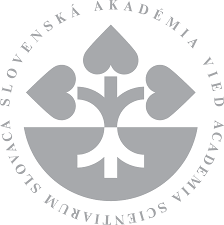


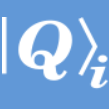
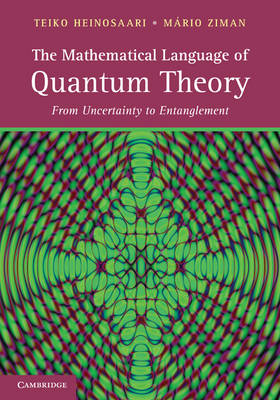
|
Anisotropic vortex squeezing in synthetic Rashba superconductors: a manifestation of Lifshitz invariants
Epitaxial superconductor-semiconductor heterostructures combine superconductivity with strong spin-orbit interaction resulting in synthetic Rashba superconductors. The theoretical description of such superconductors involves Lifshitz invariants that are predicted to feature numerous exotic effects with so far sparse experimental evidence. Using a new observable—vortex inductance—we investigate the pinning properties of epitaxial Al=InAs-based heterostructures. We find a pronounced decrease of the vortex inductance with increasing in-plane field which corresponds to a counterintuitive increase of the pinning force. When rotating the in-plane component of the field with respect to the current direction, the pinning interaction turns out to be highly anisotropic. We analytically demonstrate that both the pinning enhancement and its anisotropy are consequences of the presence of Lifshitz invariant terms in the Ginzburg-Landau free energy. Hence, our experiment provides access to a fundamental property of Rashba superconductors and offers an entirely new approach to vortex manipulation.
by
Lorenz Fuchs, Denis Kochan, Christian Baumgartner, Simon Reinhardt, Sergei Gronin, Geoffrey C. Gardner, Tyler Lindemann, Michael J. Manfra, Christoph Strunk, Nicola Paradiso
Physical Review X 12, 041020 (2022) | +++ | SUPERSPIN (IMPULZ IM-2021-26) |
 21.11.2022 Popularization (in Slovak)
21.11.2022 Popularization (in Slovak)
Skrytá mágia kvantového sveta (Hidden magic of quantum world)
Nobelovu cenu za fyziku v tomto roku získali Francúz Alain Aspect, Američan John Clauser a Rakúšan Anton Zeilinger za experimenty s kvantovo previazanými fotónmi. Príbeh kvantového previazania začal fyzik, ktorý dostal Nobelovu cenu pred 101 rokmi. Viedli ho k tomu dlhoročné diskusie s fyzikom, ktorý získal Nobelovu cenu pred 100 rokmi. Ale k tomu sa ešte dostaneme ...
by Mário Ziman
aktuality.sk → rubrika Veda, výskum - naša šanca | pdf | |
 16.11.2022 Media (in Slovak)
16.11.2022 Media (in Slovak)
Skutočného kvantového počítača sa možno nikdy nedočkáme, dnešné „kvantové počítadlá“ by mohli byť súčasťou superpočítačov interview for zive.sk with Mário Ziman (by Ján Trangel) ... read more ... |
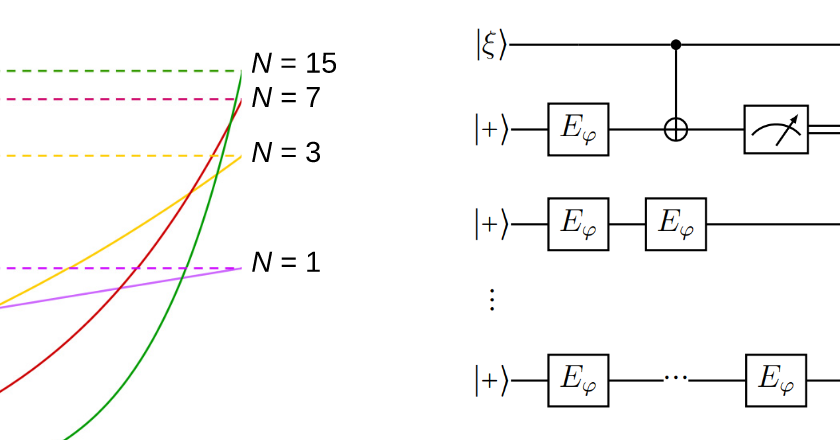 15.11.2022 Publication
15.11.2022 Publication
Robustness of optimal probabilistic storage and retrieval of unitary channels to noise
We investigate robustness of probabilistic storage and retrieval device optimized for phase gates to noise. We use noisy input composed of convex combination of unitary channel with either depolarizing or dephasing channel. We find out that the resistance to dephasing noise is higher than to depolarization. Interestingly, for the depolarization the retrieval reduces the degree of noise. We also examine the possible realizations showing that their performance is different when the noise is present.
by
Jaroslav Pavličko, Mário Ziman
Phys. Rev. A 106, 052416 (2022) | +++ | OPTIQUTE (APVV-18-0518), DESCOM (VEGA 2/0183/21), QISS (ID JTF-61466) |
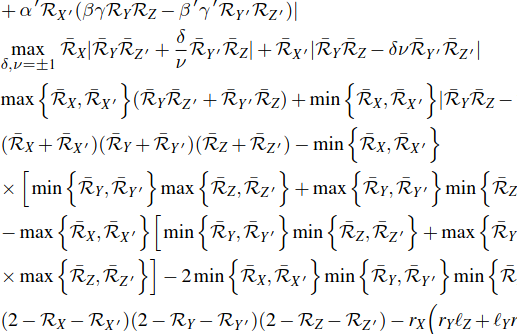 15.11.2022 Publication
15.11.2022 Publication
Mermin and Svetlichny inequalities for non-projective measurement observables
The necessary and sufficient criteria for violating the Mermin and Svetlichny inequalities by arbitrary three-qubit states are presented. Several attempts have been made, earlier, to find such criteria, however, those extant criteria are neither tight for most of the instances, nor fully general. We generalize the existing criteria for Mermin and Svetlichny inequalities which are valid for the local projective measurement observables as well as for the arbitrary ones. We obtain the maximal achievable bounds of the Mermin and Svetlichny operators with unbiased measurement observables for arbitrary three-qubit states and with arbitrary observables for three-qubit states having maximally mixed marginals. We find that for certain ranges of measurement strengths, it is possible to violate Mermin and Svetlichny inequalities only by biased measurement observables. The necessary and sufficient criteria of violating any one of the six possible Mermin and Svetlichny inequalities are also derived.
by
Mohd Asad Siddiqui, Sk Sazim
J. Phys. A: Math. Theor. 55 465301 (2022) | +++ | OPTIQUTE (APVV-18-0518), HOQIP (VEGA 2/0161/19), DESCOM (VEGA-2/0183/21), Schwarz stipendium SS |
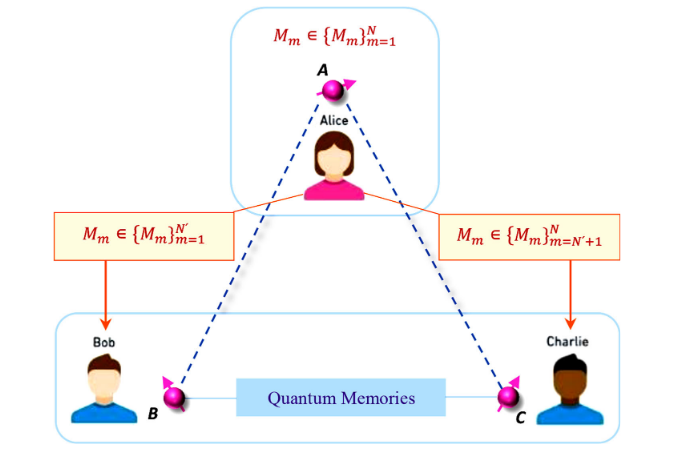 21.10.2022 Publication
21.10.2022 Publication
Tripartite quantum-memory-assisted entropic uncertainty relations for multiple measurements
Quantum uncertainty relations are typically analyzed for a pair of incompatible observables, however, the concept per se naturally extends to situations of more than two observables. In this work, we obtain tripartite quantum-memory-assisted entropic uncertainty relations for multiple measurements and show that the lower bounds of these relations have three terms that depend on the complementarity of the observables, the conditional von-Neumann entropies, the Holevo quantities, and the mutual information. The saturation of these inequalities is analyzed.
by
Hazhir Dolatkhah, Saeed Haddadi, Soroush Haseli, Mohammad Reza Pourkarimi, Mário Ziman
The European Physical Journal Plus 137, 1163 (2022) | +++ | APVV-18-0518 (OPTIQUTE), VEGA 2/0161/19 (HOQIT) |
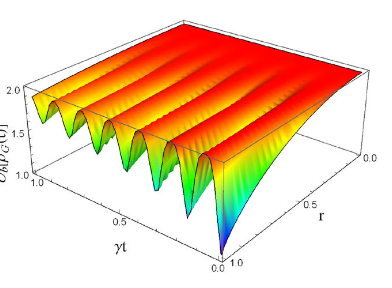 19.10.2022 Publication
19.10.2022 Publication
Characterizing tripartite entropic uncertainty under random telegraph noise
The uncertainty principle bounds the measurement precision of two complementary
variables and the bipartite scenario of quantum-memory-assisted entropic uncertainty relation (QMA-EUR) has been extensively studied. We investigate the tight uncertainty bound (UB) of a tripartite scenario of QMA-EUR in a system consisting of three qubits coupled either to their independent random telegraph noises (RTNs) or to a common source of RTN. For both the initial GHZ- and W -type states, the results show that the UB always increases monotonically with time in the Markovian regime and oscillates in the non-Markovian regime. Moreover, the UB can be significantly reduced due to the non-Markovian effects in the finite-time region and approaches the same asymptotic values in the infinite-time limit for both Markovian and non-Markovian cases.
by
Hazhir Dolatkhah, Saeed Haddadi, Ming-Liang Hu, Mohammad Reza Pourkarimi
Quantum Information Processing 21, 356 (2022) | +++ | APVV-18-0518 (OPTIQUTE), VEGA 2/0161/19 (HOQIT) |
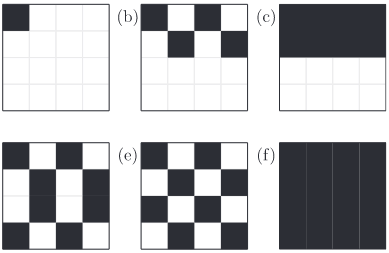 05.10.2022 Publication
05.10.2022 Publication
Pauli component erasing operations
Decoherence of quantum systems is described by quantum channels. However, a complete understanding of such channels, especially in the multiparticle setting, is still an ongoing difficult task. We propose the family of quantum maps that preserve or completely erase the components of a multiqubit system in the basis of Pauli strings, which we call Pauli component erasing maps. For the corresponding channels, it is shown that the preserved components can be interpreted as a finite vector subspace, from which we derive several properties and complete the characterization. Moreover, we show that the obtained family of channels forms a semigroup and derive its generators. We use this simple structure to determine physical implementations and connect the obtained family of channels with Markovian processes.
by
Jose Alfredo de Leon, Alejandro Fonseca, Francois Leyvraz, David Davalos, Carlos Pineda
Phys. Rev. A 106, 042604 (2022) | +++ | OPTIQUTE APVV-18-0518, DESCOM VEGA-2/0183/21, Schwarz stipendium DD |
 04.10.2022 Lectures (in Slovak)
04.10.2022 Lectures (in Slovak)
Kvantové počítanie (Quantum computing) Series of public semi-popular lectures on existing potential and current challenges of quantum computers. The lectures are taking place at Výpočtové stredisko SAV, Bratislava - Patrónka and are organized jointly by Slovak national centers for High-Performance Computation (https://eurocc.nscc.sk/) and Quantum Technologies (http://qute.sk/). Utorok 04.10.2022, 17:00 Vladimír Bužek: Úvod do fyziky kvantového počítania
Povieme si, aké sú pravidlá, ktoré sa používajú, keď hovoríme o kvantovom počítaní a ako súvisia s fyzikálnymi vlastnosťami kvantových systémov.
Utorok 18.10.2022, 17:00 Mario Ziman: Kvantové výpočty a algoritmy | youtube |
Povieme si, ako teoreticky vieme kvantové pravidlá použiť na počítanie. O kvantových výpočtoch hovoríme, keď namiesto núl a jednotiek používame kvantové bity a namiesto logických hradiel hradlá kvantové. Povieme si ako funguje kvantový výpočet akejkoľvek funkcie a ukážeme si, že niektoré z týchto výpočtov vieme spraviť na kvantových počítačoch výrazne rýchlejšie. Popritom sa dozvieme, že existujú elementárne hradlá, z ktorých vieme poskladať akýkoľvek výpočet, a preto môžeme hovoriť o univerálnom kvantovom počítači, že vymyslieť kvantový algoritmus vôbec nie je jednoduché, ale niektoré algoritmy si ukážeme, a že chyby pri kvantovom počítaní vieme opraviť.
Utorok 08.11.2022, 17:00 Daniel Reitzner: Kvantové programovanie | youtube |
Povieme si ako sú na tom súčasné kvantové procesory po praktickej a technickej stránke, a ako to zapadá do oblasti vysokovýkonného počítania. Existuje množstvo platforiem, z ktorých každá má svoje prednosti a svoje nedostatky. Avšak zatiaľ všetky oplývajú vysokou chybovosťou a malým množstvom použiteľných qubitov. V dnešnej dobe je tak potrebné hľadať cestu, ako s týmito obmedzeniami pracovať. To sa deje jednak optimalizáciou na úrovni samotných výpočtov a jednak na algoritmickej úrovni, kde hľadáme (nenáročné) výpočty, pri ktorých dané obmedzenia nie sú zničujúce, ale zároveň pri ktorých môžeme očakávať aspoň čiastočné výhody (napr. v urýchlení výpočtov).
Utorok 22.11.2022, 17:00 Daniel Nagaj: Kvantová zložitosť a simulácie | youtube |
Povieme si, kedy a kde má zmysel kvantové výpočty používať, a ktoré problémy a systémy bude ťažké počítať aj na počítačoch kvantových.
|
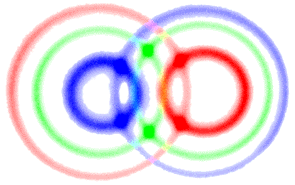 04.10.2022 Event
04.10.2022 Event
Nobel Prize for entanglement We are happy to spread the news that this year Nobel Prize was awarded to our distinguished colleagues Alain Aspect, John F. Clauser and Anton Zeilinger for their experiments with entangled photons, establishing the violation of Bell inequalities and pioneering quantum information science. As said on the NobelPrize website "their results have cleared the way for new technology based upon quantum information" and we know what they are talking about. CONGRATULATIONS !!! https://www.nobelprize.org/prizes/physics/2022/summary/ |
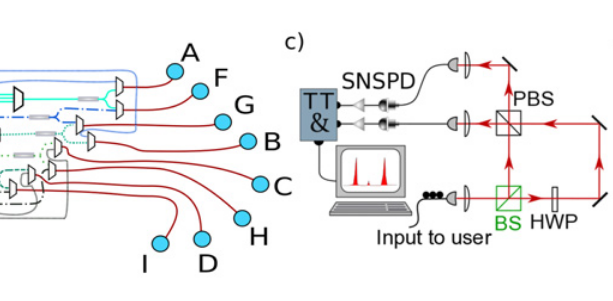 03.10.2022 Publication
03.10.2022 Publication
Unconditionally secure digital signatures implemented in an 8-user quantum network
The ability to know and verifiably demonstrate the origins of messages can often be as important as encrypting the message itself. Here we present an experimental demonstration of an unconditionally secure digital signature (USS) protocol implemented for the first time, to the best of our knowledge, on a fully connected quantum network without trusted nodes. We choose a USS protocol which is secure against forging, repudiation and messages are transferrable. We show the feasibility of unconditionally secure signatures using only bi-partite entangled states distributed throughout the network and experimentally evaluate the performance of the protocol in real world scenarios with varying message lengths.
by
Yoann Pelet, Ittoop Vergheese Puthoor, Natarajan Venkatachalam, Sören Wengerowsky, Martin Lončarić, Sebastian Philipp Neumann, Bo Liu, Željko Samec, Mário Stipčević, Rupert Ursin, Erika Andersson, John G. Rarity, Djeylan Aktas, Siddarth Koduru Joshi
New Journal of Physics 24, 093038 (2022) | +++ | NONE |
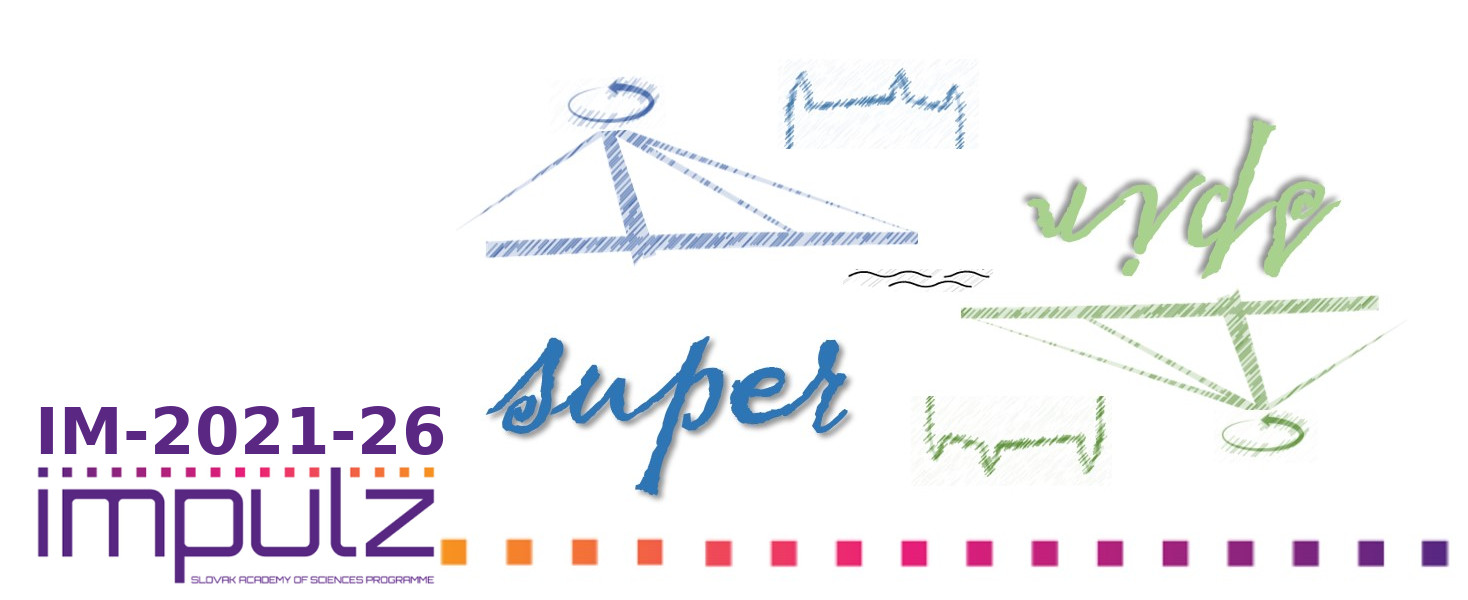 26.09.2022 Event
26.09.2022 Event
Miniworkshop on superconductivity 03-05/10/2022, Institute of Physics SAS, Bratislava, Slovakia (Auditorium QUTE) MONDAY 03/10 download program TUESDAY 04/10 WEDNESDAY 05/10 organized by Denis Kochan, Maria Surovcova, Angelika Winczerova, Mario Ziman supported by project SUPERSPIN (IMPULZ) |
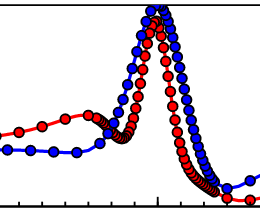 26.08.2022 Publication
26.08.2022 Publication
Free-Fermionic Topological Quantum Sensors
Second order quantum phase transitions, with well-known features such as long-range entanglement, symmetry breaking, and gap closing, exhibit quantum enhancement for sensing at criticality. However, it is unclear which of these features are responsible for this enhancement. To address this issue, we investigate phase transitions in free-fermionic topological systems that exhibit neither symmetry-breaking nor long-range entanglement. We analytically demonstrate that quantum enhanced sensing is possible using topological edge states near the phase boundary. Remarkably, such enhancement also endures for ground states of such models that are accessible in solid state experiments. We illustrate the results with 1D Su-Schrieffer-Heeger chain and a 2D Chern insulator which are both experimentally accessible. While neither symmetry-breaking nor long-range entanglement are essential, gap closing remains as the major candidate for the ultimate source of quantum enhanced sensing. In addition, we also provide a fixed and simple measurement strategy that achieves near-optimal precision for sensing using generic edge states irrespective of the parameter value. This paves the way for development of topological quantum sensors which are expected to also be robust against local perturbations.
by
Saubhik Sarkar, Chiranjib Mukhopadhyay, Abhijeet Alase, Abolfazl Bayat
Phys. Rev. Lett. 129, 090503 (2022) | +++ | OPTIQUTE APVV-18-0518, DESCOM VEGA-2/0183/21, Schwar stipend CM |
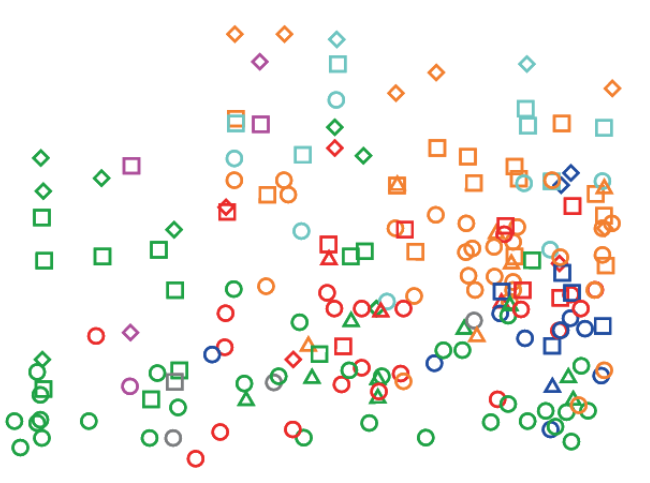 17.08.2022 Publication
17.08.2022 Publication
Review of performance metrics of spin qubits in gated semiconducting nanostructures
This Technical Review collects values of selected performance characteristics of
semiconductor spin qubits defined in electrically controlled nanostructures. The characteristics are envisaged to serve as a community source for the values of figures of merit with agreed definitions allowing the comparison of different spin-qubit platforms. We include characteristics on the qubit coherence, speed, fidelity and qubit size of multi-qubit devices. The focus is on collecting and curating the values of these characteristics as reported in the literature, rather than on their motivation or significance.
by
Peter Stano, Daniel Loss
Nature Reviews Physics 4, 672–688 (2022) | +++ | NONE |
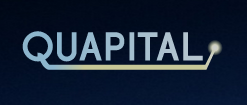 27.07.2022 Event
27.07.2022 Event
Quapital Summer School 2022 4-8 September 2022, Smolenice, Slovakia, We are organizing a school on quantum cryptography covering subjects from theoretical backgrond to practical implementation. For more details visit the school website http://qute.sk/quapital2022.html . Open and accessible for everybody (including interested industries). |
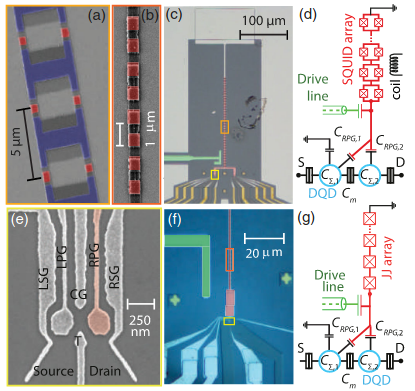 07.07.2022 Publication
07.07.2022 Publication
In situ Tuning of the Electric-Dipole Strength of a Double-Dot Charge Qubit: Charge-Noise Protection and Ultrastrong Coupling
Semiconductor quantum dots in which electrons or holes are isolated via electrostatic potentials generated by surface gates are promising building blocks for semiconductor-based quantum technology. Here, we investigate double-quantum-dot (DQD) charge qubits in GaAs capacitively coupled to high-impedance superconducting quantum interference device array and Josephson-junction array resonators. We tune the strength of the electric-dipole interaction between the qubit and the resonator in situ using surface gates. We characterize the qubit-resonator coupling strength, the qubit decoherence, and the detuning noise affecting the charge qubit for different electrostatic DQD configurations. We find all quantities to be systematically tunable over more than one order of magnitude, resulting in reproducible decoherence rates &Gamma2=2π < 5 MHz in the limit of high interdot capacitance. In the opposite limit, by reducing the interdot capacitance, we increase the DQD electric-dipole strength and, therefore, its coupling to the resonator. Employing a Josephson-junction array resonator with an impedance of approximately 4 kΩ and a resonance frequency of ωr =2π ∼ 5.6 GHz, we observe a coupling strength of g=2π ∼ 630 MHz, demonstrating the possibility to operate electrons hosted in a semiconductor DQD in the ultrastrong-coupling regime (USC). The presented results are essential for further increasing the coherence of quantum-dot-based qubits and investigating USC physics in semiconducting QDs.
by
P. Scarlino, J. H. Ungerer, D. J. van Woerkom, M. Mancini, P. Stano, C. Müller, A. J. Landig, J. V. Koski, C. Reichl, W. Wegscheider, T. Ihn, K. Ensslin, and A. Wallraff
Physical Review X 12, 031004 (2022) | +++ | NONE |
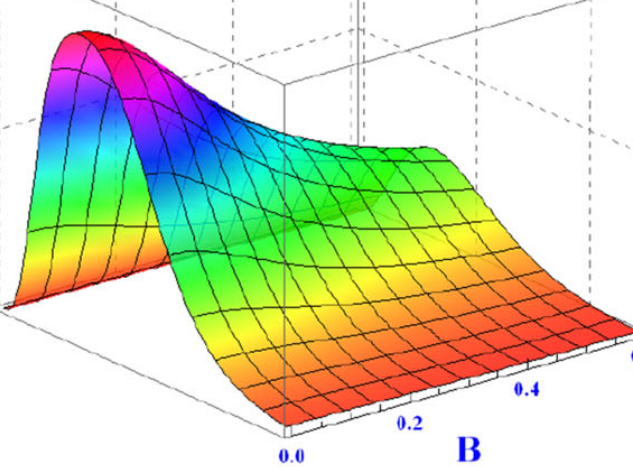 30.06.2022 Publication
30.06.2022 Publication
Non-classical correlations in a Heisenberg spin model with Heitler–London approach
The isotropic Heisenberg two-spin-1/2 model in the XXX configuration under an external transverse nonuniform magnetic field is considered at thermal equilibrium. In the context of the Heitler–London approach, the variation of the spin–spin exchange coupling strength in terms of the position is adopted. The effects of the inter-spin relative coupling distance r and nonuniform magnetic field on the thermal evolution of quantum correlations are studied in detail. By tuning the coupling distance r , temperature T and nonuniform magnetic field B, quantum correlations can be scaled in the bipartite system. Astonishingly, we find the long sustainable behavior of geometric quantum discord in comparison with entanglement over the coupling distance r. Moreover, we show the existence of separable quantum states with nonzero quantum correlations in terms of trace discord. Besides, the quantum correlations shared between the considered bipartite system parts are only the entanglement type for a fixed temperature and suitable strong nonuniform magnetic field values. An entangled-unentangled phase transition at T = 0.1 with threshold relative distance rf can be detected by the entanglement behavior in terms of B and r. A kind of correspondence between thermal entanglement and thermal non-classical correlations for a strong value of B can be observed. It is our hope that this research may open a new path to consider the role of Heitler–London approach in non-classical correlations preservation.
by
Youssef Khedif, Saeed Haddadi, Mohammed Daoud, Hazhir Dolatkhah, Mohammad Reza Pourkarimi
Quantum Information Processing 21, 235 (2022) | +++ | APVV-18-0518 (OPTIQUTE), VEGA 2/0161/19 (HOQIT) |
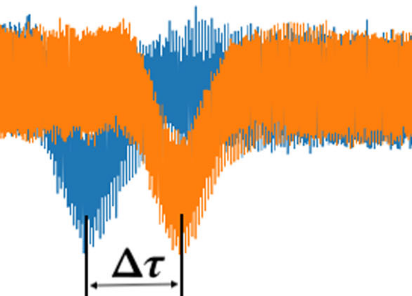 16.05.2022 Publication
16.05.2022 Publication
Quantum-limited determination of refractive index difference by means of entanglement
Shaping single-mode operation in high-power fibers requires a precise knowledge of the gain-medium optical properties. This requires precise measurements of the refractive index differences (Δn) between the core and the cladding of the fiber. We exploit a quantum optical method based on low-coherence Hong-Ou-Mandel interferometry to perform practical measurements of the refractive index difference using broadband energy-time entangled photons. The precision enhancement reached with this method is benchmarked with a classical method based on single photon interferometry. We show in classical regime an improvement by an order of magnitude of the precision compared to already reported classical methods. Strikingly, in the quantum regime, we demonstrate an extra factor of 4 on the precision enhancement, exhibiting a state-of-the-art Δn precision of 6×10−7 . This work sets the quantum photonics metrology as a powerful characterization tool that should enable a faster and reliable design of materials dedicated to light amplification.
by
Mattis Reisner, Florent Mazeas, Romain Dauliat, Baptiste Leconte, Djeylan Aktas, Rachel Cannon, Philippe Roy, Raphael Jamier, Gregory Sauder, Florian Kaiser, Sébastien Tanzilli, Laurent Labonté
npj Quantum Information 8, 58 (2022) | +++ | NONE |
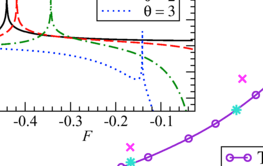 06.05.2022 Publication
06.05.2022 Publication
Ising ferromagnets and antiferromagnets in an imaginary magnetic field
We study classical Ising spin-1/2 models on a two-dimensional (2D) square lattice with ferromagnetic or antiferromagnetic nearest-neighbor interactions, under the effect of a pure imaginary magnetic field. The complex Boltzmann weights of spin configurations cannot be interpreted as a probability distribution, which prevents application of standard statistical algorithms. In this work, the mapping of the Ising spin models under consideration onto symmetric vertex models leads to real (positive or negative) Boltzmann weights. This enables us to apply accurate numerical methods based on the renormalization of the density matrix, namely, the corner transfer matrix renormalization group and the higher-order tensor renormalization group. For the 2D antiferromagnet, varying the imaginary magnetic field, we calculate with high accuracy the curve of critical points related to the symmetry breaking of magnetizations on the interwoven sublattices. The critical exponent β and the anomaly number C are shown to be constant along the critical line, equal to their values β=1/8 and C=1/2 for the 2D Ising model in a zero magnetic field. The 2D ferromagnets behave in analogy with their 1D counterparts defined on a chain of sites, namely, there exists a transient temperature which splits the temperature range into its high-temperature and low-temperature parts. The free energy and the magnetization are well defined in the high-temperature region. In the low-temperature region, the free energy exhibits singularities at the Yang-Lee zeros of the partition function and the magnetization is also ill-defined: It varies chaotically with the size of the system. The transient temperature is determined as a function of the imaginary magnetic field by using the fact that from the high-temperature side both the first derivative of the free energy with respect to the temperature and the magnetization diverge at this temperature.
by
Roman Krčmár, Andrej Gendiar, and Ladislav Šamaj
Phys. Rev. E 105, 054112 (2022) | +++ | QUASIMODO (VEGA 2/0092/21), SAS-MOST 108-2112-M002-020-MY3, PRESPEED (APVV-20-0150) |
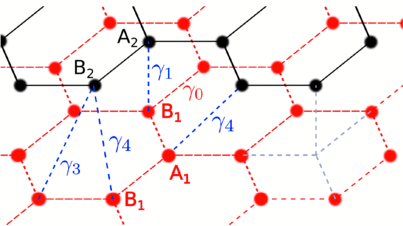 05.05.2022 Publication
05.05.2022 Publication
Spin relaxation, Josephson effect, and Yu-Shiba-Rusinov states in superconducting bilayer graphene
Bilayer graphene has two nonequivalent sublattices and, therefore, the same adatom impurity can manifest in spectrally distinct ways—sharp versus broad resonances near the charge neutrality—depending on the sublattice it adsorbs at. Employing Green's function analytical methods and the numerical kwant package, we investigate the spectral and transport interplay between the resonances and superconducting coherence induced in bilayer graphene by proximity to an s-wave superconductor. Analyzing doping and temperature dependencies of quasiparticle spin-relaxation rates, energies of Yu-Shiba-Rusinov states, Andreev spectra, and the supercurrent characteristics of Josephson junctions, we find unique superconducting signatures discriminating between resonant and off-resonant regimes. Our findings are in certain aspects going beyond the superconducting bilayer graphene and hold for generic s-wave superconductors functionalized by the resonant magnetic impurities.
by
Michael Barth, Jacob Fuchs, and Denis Kochan
Phys. Rev. B 105, 205409 (2022) | +++ | IMPULZ SUPERSPIN, |
 02.05.2022 Event
02.05.2022 Event
Quantum Rendezvous National Center for Quantum Technologies QUTE.sk is organising a national strategic meeting focused on development of quantum technologies in Slovakia. Date: 29/06/2022 – 01/07/2022 http://qute.sk/qrendezvous2022.html The meeting is aiming to put together all interested researchers, stakeholders and industrial partners. |
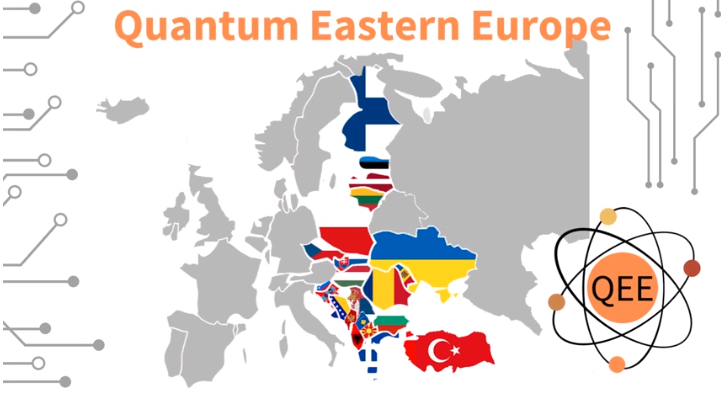 25.04.2022 Event
25.04.2022 Event
Quantum Eastern Europe Quantum Eastern Europe (QEE) is a 2-day online event that will bring together those stakeholders in Eastern Europe for whom quantum science and technology is relevant. The event will raise awareness and transfer knowledge about quantum science and technology, foster synergies and collaborations between academia, industry, government, and interested individuals, and thereby strengthen the quantum ecosystem in this geographical area. Date: 5 – 6 May 2022 https://quantumeasterneurope.com/ Our colleagues are participating too. Pavol Neilinger will give a "lightning" talk there and Mario Ziman will be taking part in V4 panel discussion. |
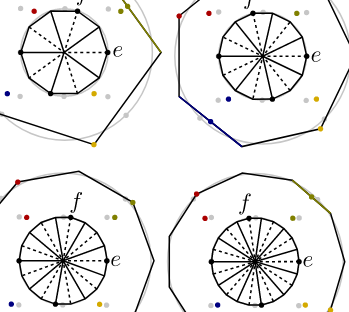 04.04.2022 Publication
04.04.2022 Publication
Random access test as an identifier of nonclassicality
Random access codes (RACs) are an intriguing class of communication tasks that reveal an operational and quantitative difference between classical and quantum information processing. We formulate a natural generalization of RACs and call them random access tests (RATs), defined for any finite collection of measurements in an arbitrary finite dimensional general probabilistic theory. These tests can be used to examine collective properties of collections of measurements. We show that the violation of a classical bound in a RAT is a signature of either measurement incompatibility or super information storability. The polygon theories are exhaustively analysed and a critical difference between even and odd polygon theories is revealed.
by
Teiko Heinosaari, Leevi Leppäjärvi
J. Phys. A: Math. Theor. 55, 174003 (2022) | +++ | APVV-18-0518 (OPTIQUTE), VEGA 2/0183/21 (DESCOM), Schwarz stipend LL |
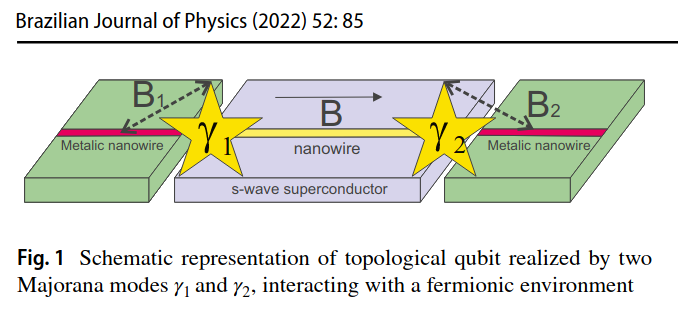 28.03.2022 Publication
28.03.2022 Publication
Quantum Speed Limit Time of Topological Qubits Influenced by the Fermionic and Bosonic Environments
Quantum theory sets a bound on the minimum time required to transform from an initial state to a target state. The bound is known as quantum speed limit time. Quantum speed limit time can be used to determine the rate of quantum evolution for closed and open quantum systems. In the real world, we are dealing with open quantum systems. So, the study of quantum speed limit time for open quantum systems has particular importance. In this work, we consider the topological qubit realized by two Majorana modes. We consider the case in which the topological qubit is influenced by the fermionic and bosonic environment. Fermionic and bosonic environments are assumed to have Ohmic-like spectral density. The quantum speed limit time is investigated for the various environments with different Ohmic parameters. It is observed that for the super-Ohmic environment with increasing Ohmic parameter the quantum speed limit time gradually reaches a constant value and so the speed of evolution reaches a uniform value. It is also observed that the quantum speed limit time reaches zero value by increasing initial time parameter for small value of Ohmic parameter while it reaches constant value for larger Ohmic parameter. The effects of the external magnetic field on the quantum speed limit time are also studied. It is observed that with increasing magnitude of the magnetic field, the quantum speed limit time decreases.
by
Fatemeh Ahmadi, Soroush Haseli, Maryam Hadipour, Sara Heshmatian, Hazhir Dolatkhah and Shahriar Salimi
Brazilian Journal of Physics 52, 85 (2022) | +++ | NONE |
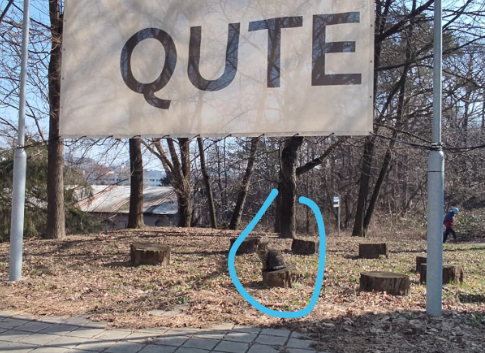 12.03.2022 Job opening
12.03.2022 Job opening
Seeking for quantum PhD students. Are you a master/engineer student fascinated by quantum physics or future of quantum technologies? Want to run quantum computers, build quantum network, or encrypt quantum messages?. Interested to join our research team for four years of you life? That is the time it takes to do the research and become expert (with PhD title) in quantum simulations, or optical quantum communication networks, or quantum security, or foundations of quantum phenomena. All of these fields are waiting for your contribution. Currently, we have open several PhD positions at our Institute. We are open for submissions until 10/04/2022, exceptionally also later) with PhD starting in September 2022. If interested, as the first step, please get in contact with a potential PhD advisor (send him your cv, motivation letter and contacts to potential references), discuss the subject and follow his/her instructions. Do not wait until the submission deadline and do this as soon as possible. If you are uncertain who to contact, just choose any of us. We are all happy to help you to select your quantum destiny. |
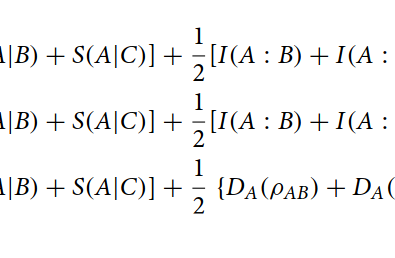 08.03.2022 Publication
08.03.2022 Publication
The tripartite quantum-memory-assisted entropic uncertainty relation and upper bound on shareability of quantum discord
Quantum discord and quantum uncertainty are two important features of the quantum world. In this work, the relation between entropic uncertainty relation and the shareability of quantum discord is studied. By using tripartite quantum‑memory‑assisted entropic uncertainty relation, an upper bound for the shareability of quantum discord among different parties of a composite system is obtained. It is also shown that, for a specific class of tripartite states, the obtained relation could be expressed as monogamy of quantum discord. Moreover, it is illustrated that the relation could be generalized and an upper bound for the shareability of quantum discord for multipartite states is derived.
by
Hazhir Dolatkhah, Abolhassan Mohammadi, Soroush Haseli
Scientific Reports 12, 4101 (2022) | +++ | NONE |
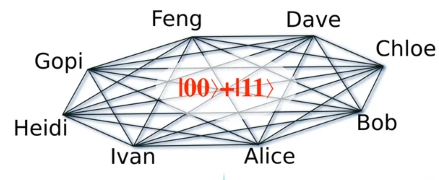 07.03.2022 Publication
07.03.2022 Publication
Experimental implementation of secure anonymous protocols on an eight-user quantum key distribution network
Anonymity in networked communication is vital for many privacy-preserving tasks. Secure key distribution alone is insufficient for high-security communications. Often, knowing who transmits a message to whom and when must also be kept hidden from an adversary. Here, we experimentally demonstrate five information-theoretically secure anonymity protocols on an eight user city-wide quantum network using polarisation entangled photon pairs. At the heart of these protocols is anonymous broadcasting, which is a cryptographic primitive that allows one user to reveal one bit of information while keeping their identity anonymous. For a network of n users, the protocols retain anonymity for the sender, given that no more than n − 2 users are colluding. This is an implementation of genuine multi-user cryptographic protocols beyond standard QKD. Our anonymous protocols enhance the functionality of any fully-connected Quantum Key Distribution network without trusted nodes.
by
Zixin Huang, Siddarth Koduru Joshi, Djeylan Aktas, Cosmo Lupo, Armanda O. Quintavalle, Natarajan Venkatachalam, Sören Wengerowsky, Martin Lončarić, Sebastian Philipp Neumann, Bo Liu, Željko Samec, Laurent Kling, Mario Stipčević, Rupert Ursin & John G. Rarity
npj Quantum Information 8, 25 (2022) | +++ | NONE |
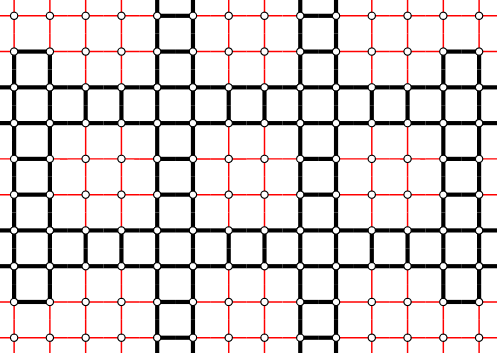 18.02.2022 Publication
18.02.2022 Publication
J1-J2 fractal studied by multirecursion tensor-network method
We generalize a tensor-network algorithm to study the thermodynamic properties of self-similar spin lattices constructed on a square-lattice frame with two types of couplings, J1 and J2 , chosen to transform a regular square lattice (J1 = J2 ) onto a fractal lattice if decreasing J2 to zero (the fractal fully reconstructs when J2 = 0). We modified the higher-order tensor renormalization group (HOTRG) algorithm for this purpose. Single-site measurements are performed by means of so-called impurity tensors. So far, only a single local tensor and uniform extension-contraction relations have been considered in HOTRG. We introduce 10 independent local tensors, each being extended and contracted by 15 different recursion relations. We applied the Ising model to the J1 − J2 planar fractal whose Hausdorff dimension at J2 = 0 is d(H ) = ln 12/ ln 4 ≈ 1.792. The generalized tensor-network algorithm is applicable to a wide range of fractal patterns and is suitable for models without translational invariance.
by
Jozef Genzor, Andrej Gendiar, Ying-Jer Kao
Phys. Rev. E 105, 024124 (2022) | +++ | JSR SAS-MOST 108-2112-M-002-020-MY3, APVV-18-0518 (OPTIQUTE), APVV-16-0186 (EXSES), VEGA 2/0123/19 (CRIPONT), JTF ID# 61466 (QISS) |
 12.02.2022 Job opening
12.02.2022 Job opening
Postdoc opening We are seeking for postdocs in the area of quantum communication technologies. We are interested for candidates of experimental and theoretical background in the area of quantum communication engineering, or experimental quantum optics, or quantum information theory. The positions are offered for one year (extensions for couple of more years are possible, but details depend on the particular financial source) with a basic gross salary from 1800 eur/month and flexible expected start (earliest from June 2022). The application consists of CV (including list of publications), research statement (short summary of personal research interests and plans), and three names of potential referee we might ask for recommendation letters. Please send all this information to Mario Ziman by email (ziman@savba.sk) before 31/03/2022. Only complete applications will be considered. |
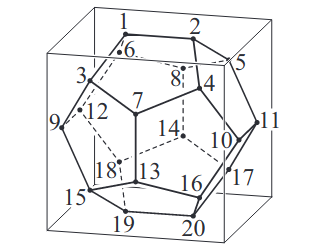 03.02.2022 Publication
03.02.2022 Publication
Energy Scale Deformation on Regular Polyhedra
A variant of energy scale deformation is considered for the S = 1/2 antiferromagnetic Heisenberg model on polyhedra. The deformation is induced by the perturbations to the uniform Hamiltonian, whose coefficients are determined by the bond coordinates. On the tetrahedral, octahedral, and cubic clusters, the perturbative terms do not affect the ground state of the uniform Hamiltonian when they are sufficiently small. On the other hand, for the icosahedral and dodecahedral clusters, it is numerically confirmed that the ground state of the uniform Hamiltonian is almost insensitive to the perturbations unless they lead to a discontinuous change in the ground state. The obtained results suggest the existence of a generalization of sine-square deformation in higher dimensions.
by
Takuya Eguchi, Satoshi Oga, Hosho Katsura, Andrej Gendiar, and Tomotoshi Nishino,
J. Phys. Soc. Jpn. 91, 034001 (2022) [6 Pages] | +++ | NONE |
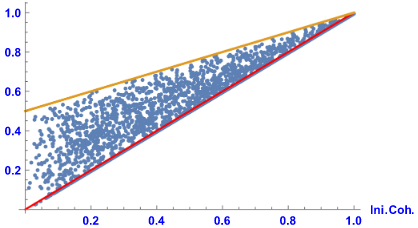 19.01.2022 Publication
19.01.2022 Publication
Creation of quantum coherence with general measurement processes
Quantum measurement not only can destroy coherence but also can create it. Here, we estimate the maximum amount of coherence, one can create under a complete non-selective measurement process. For our analysis, we consider projective as well as POVM measurements. Based on our observations, we characterize the measurement processes into two categories, namely, the measurements with the ability to induce coherence and the ones without this ability. Our findings also suggest that the more POVM elements present in a measurement that acts on the quantum system, the less will be its coherence creating ability. We also introduce the notion of raw coherence in the POVMs that helps to create quantum coherence. Finally, we find a trade-off relation between the coherence creation, entanglement generation between system and apparatus, and the mixedness of the system in a general measurement setup.
by
Sanuja D. Mohanty, Gautam Sharma, Sk Sazim, Biswajit Pradhan, Arun K. Pati
Quantum Information Processing 21, 48 (2022) | +++ | Schwarz, OPTIQUTE (APVV-18-0518), HOQIP (VEGA 2/0161/19) |
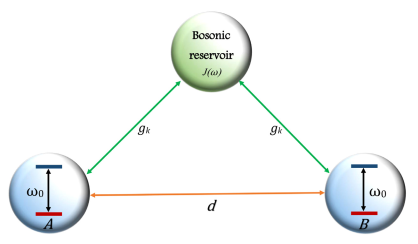 04.01.2022 Publication
04.01.2022 Publication
Measurement uncertainty and dense coding in a two-qubit system: Combined effects of bosonic reservoir and dipole–dipole interaction
The uncertainty principle imposes a limitation on the measurement accuracy of two incompatible observables and has potential applications in quantum information science. We explore the bipartite entropic uncertainty relation and dense coding for two qubits coupled via dipole–dipole interaction and subject to a bosonic reservoir. It is shown that there exists a trade-off between the uncertainty bound and the dense coding capacity which results in their opposite dynamical behaviors. Moreover, the behaviors of the measurement uncertainty and the dense coding capacity rely crucially on the initial system–reservoir correlation, the strength of the dipole–dipole interaction, and the degree of non-Markovianity, and one can reduce the measurement uncertainty and enhance the dense coding capacity by tuning these parameters to appropriate values.
by
Saeed Haddadi, Ming-Liang Hu, Youssef Khedi, Hazhir Dolatkhah, Mohammad Reza Pourkarimi, Mohammed Daoud
Results in Physics 32, 105041 (2022) | +++ | APVV-18-0518 (OPTIQUTE) VEGA 2/0161/19 (HOQIT) |


